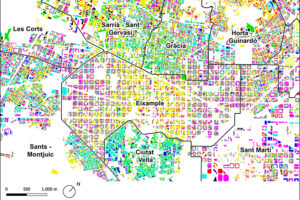TECHNOLOGY CAPACITIES
Urban planning, environment and landscape

Landscape design
Study of the form and structure of the landscape, its connection with territorial planning and innovation in instruments of development.

Urban analysis and design
Models, techniques and methods of urban design applied to the construction of cities. Study of urban transformation policies.

Environment
Analysis and measurement of heat islands. Generation of models for integration into software simulations.

Noise pollution
Analysis of noise pollution in the urban environment caused by mobility, bar terraces, etc.
Waste management

Organic waste
Reuse of organic waste for agriculture, obtaining new materials and recovering incineration waste.

Plastic waste
Recycling of plastic material, conversion of this into new plastics. Search for new techniques for recycling plastics.

Wastewater
Search for new methods for regenerating water, use of microalgae and other methods such as biotechnology, advanced materials or ICT.
Public space and urban infrastructure

Public space
Creation of urban furniture to mitigate the overcrowding of public space, improvement in accessibility for people with mobility difficulties.

Tourism impact
Study of tourism impact on urban areas and alternatives for more sustainable tourism.
Facilities and heritage

Historical buildings
Studies on rehabilitation and restoration of historic buildings, assistance in conservation and proposals for new uses.

Public buildings
Reports on the maintenance and sustainability of public buildings and programming of public facilities.
Housing

Rehabilitation of housing
Multiscale techniques for experimental and numerical analysis and the reliability of structures.

Reports and studies on sustainability and housing
Studies to improve the model of energy certificates for the home; improve habitability conditions and reduce energy demand. Energy rehabilitation for office building stock.

Residential building stock
Social and spatial indicators to improve residential building stock, preparation of proposals for public housing.
APPLICATION SECTORS
INFRASTRUCTURE
GOVERNMENT
PEOPLE
URBAN PLANNING
RECYCLING
HEALTH
PROJECTES RELACIONATS
- The La Volta project foresees the construction of a large Catalan vault pergola within the Llars Mundet campus, in the Montbau neighbourhood (Horta-Guinardó district). This structure will become a new architectural landmark for Barcelona, combining traditional construction techniques with contemporary innovation. The project involves the Rehabilitation and Architectural Restoration Research Group (REARQ), at the Universitat Politècnica de Catalunya - BarcelonaTech (UPC), and is led by the Architects’ Association of Catalonia (COAC) and the Barcelona Provincial Council.
- The Architecture, Energy and Environment (AiEM) research group at the Universitat Politècnica de Catalunya - BarcelonaTech (UPC) has characterised Barcelona’s residential buildings according to their capacity to adapt to climate change. This study is part of the project ‘VeUvE: Urban havens for vulnerable zones’. The work highlights the climate inequality conditions present across different areas of the city and will help to better define the priorities and energy renovation strategies for its districts.
- The Research Center for Supervision, Safety and Automatic Control (CS2AC-UPC) at the Universitat Politècnica de Catalunya - BarcelonaTech (UPC) has coordinated the SaCoAV project, focused on researching new methods and tools to ensure the safe coordination of autonomous vehicles in urban environments.
- The Centre for Technological Risk Studies (CERTEC) at UPC is participating in the WUITIPS project (Wildland-Urban-Interface Fire Touristic Infrastructure Protection Solutions), which aims to develop a new wildfire management framework for the tourism sector. This project contributes to risk analysis and the design of specific strategies to mitigate such risks.




